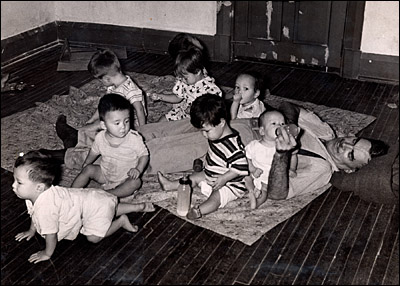
This photograph was taken in the mid-1950s.
Our first full day in Korea was spent at Il San. This allowed us to help with the time adjustment and to get to know our fellow travelers. I was still amazed that I was in Korea and with Korean adoptees. I found myself wanting to know about each adoptee and their bio-history. I wondered if they had the same life that I did. In addition, I didn't know if I would be out-Koreaned by some of these folks. Could they speak Korean? I was trying to rely on my limited exposure to other people of Asian descent.
In 8th grade, there was a boy who wore a belt buckle with the name "Bobby" on it. He was Chinese. My adolescent mentality led me to believe that he wanted people to remind him that his American name was Bobby or maybe, he didn't want anyone to butcher the pronunciation of his Chinese name? I attended a high school that split after my sophomore year and there was a very nice girl who was Korean American. We only attended the same school for two years. I credit her for giving me my 1st taste of Korean food. She used to joke that her mother would bury jars of kimchi in their backyard. Naive, I imagined her mother outside with a shovel in the summer and retrieving jars of kimchi in the cold winter. Finally, the only other Asian American girl in my graduating class was Chinese American. She was taller and wore black eye liner. With this as my only social interaction with other Asian Americans, I was looking forward to getting to know these adoptees and hoping to learn much more from this new cohort.
Back to the tour. Our first morning was spent touring the residence at Il San. As I mentioned earlier, we were spending several nights here and this is where children who were not adopted for some reason, primarily due to their special needs, lived. Oh, there were also a few residents who did have families but were at this location in order to receive care.
I think that it is safe to say that it was shocking for us all to see these children and young people living in a group environment. At this point in my life, I never considered those who were not adopted. I assumed that any child who was relinquished to the Korean social services would be adopted and I was ignorant about those with special needs. My roommates and I later shared that we all quietly thought that one of those residents could have easily been one of us. Furthermore, many of us felt guilty that we were adopted and these children were not.
We got to see where they lived, attended school, received therapy, socialized and ate. I remember a teenage boy who was in a wheelchair and a caregiver was feeding him. I am guessing that he had cerebral palsy. I distinctly recall that we all grew silent upon meeting him. To think that we were adopted and had families while these children grew up in an institutionalized setting resonated with many of us throughout the trip.
One of the most meaningful parts of this day's tour was to visit the gravesite of the founder of our agency. He was an American who along with his wife adopted eight children who were fathered by American soldiers during the Korean War. From this, he saw a greater need and was commited to finding forever families for those Korean children who were abandoned. He died in 1964 and was buired at Il San. For many, he is known as the father of international adoption.

 Seoul Time
Seoul Time


1 comment:
Seeing pictures of Ilsan makes my heartache, so I can only imagine the impact in person. I am enjoying the beautiful story of your trip and can't wait to hear more!
Post a Comment